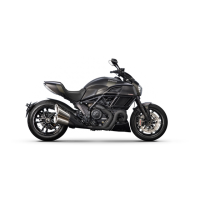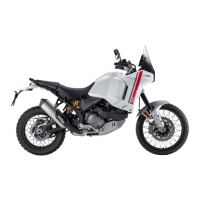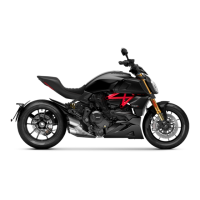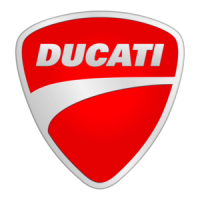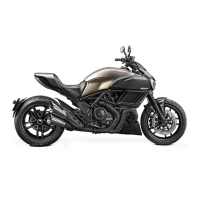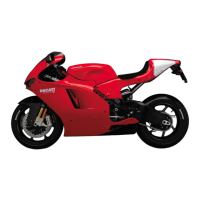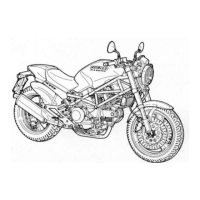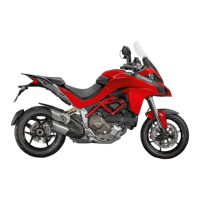Do you have a question about the Ducati DUCATI999 and is the answer not in the manual?
Information regarding the warranty for Ducati motorcycles, including exclusions and conditions.
Explanation of warning, important, and note symbols used throughout the manual.
Guidelines and precautions for safe operation of the motorcycle.
Details on the total weight limit and distribution for safe motorcycle operation.
Locating and identifying the motorcycle's frame number for identification.
Locating and identifying the motorcycle's engine number for identification.
Diagram and list identifying the location and function of various motorcycle controls.
How to cycle through trip meter, odometer, and lap time indications.
How to cycle through battery voltage, air temperature, and consumption indications.
Instructions for recording lap times, top speed, and engine RPM during a lap.
Explanation of the automatic adjustment of LCD and warning lights intensity.
Description of the provided keys (red and black) and their functions.
Procedure for obtaining duplicate keys and programming them.
Function of the dip switch for controlling low and high beam headlights.
Operation of the turn indicator switch for left, right, and off positions.
Function of the button for operating the warning horn.
Function of the button for activating the passing light feature.
Function of the right-hand switch for controlling lights.
Operation of the engine stop switch for emergency shutdown and restart.
Function of the button for starting the engine.
Method for approximate adjustment of the gear change pedal position.
Method for fine adjustment of the gear change pedal position.
Using both approximate and fine adjustment techniques for the gear change pedal.
Diagram identifying the location of main motorcycle components.
How to open the seat and use the helmet fastening cable.
Recommended procedures for breaking in the new motorcycle to ensure longevity.
Guidelines for operating the motorcycle between 1000 and 2500 km.
Procedure for starting the engine under normal ambient temperature conditions.
Instructions for removing the motorcycle fairing for servicing.
Steps to remove the side body panels on the biposto version.
Steps to remove the side body panels on the monoposto version.
Troubleshooting clutch system issues related to air in the circuit.
Troubleshooting brake system issues related to lever play or pad condition.
Instructions for replacing the high beam, low beam, and parking light bulbs.
Recommended tyre pressures for front and rear, and adjustments for temperature.
Guidelines for repairing or replacing tubeless tyres and wheel balancing.
Specifications for dry weight and maximum carrying load capacity.
Diagram showing the overall dimensions of the motorcycle.
Explanation of the Desmodromic timing system components and operation.
Specifications for the front brake system, including disc and calipers.
Specifications for the rear brake system, including disc and calipers.
Specifications for the front tyre.
Specifications for the rear tyre.
Description of the front hydraulic upside-down fork and its adjusters.
Description of the rear suspension system and its adjusters.
Procedure for reporting safety defects to NHTSA and Ducati North America.
General safety warnings and traffic rules applicable to motorcycle riding.
Warranty information for the exhaust system's compliance with noise standards.
Information on emissions control, source of emissions, and exhaust system.
Information regarding the warranty for Ducati motorcycles, including exclusions and conditions.
Explanation of warning, important, and note symbols used throughout the manual.
Guidelines and precautions for safe operation of the motorcycle.
Details on the total weight limit and distribution for safe motorcycle operation.
Locating and identifying the motorcycle's frame number for identification.
Locating and identifying the motorcycle's engine number for identification.
Diagram and list identifying the location and function of various motorcycle controls.
How to cycle through trip meter, odometer, and lap time indications.
How to cycle through battery voltage, air temperature, and consumption indications.
Instructions for recording lap times, top speed, and engine RPM during a lap.
Explanation of the automatic adjustment of LCD and warning lights intensity.
Description of the provided keys (red and black) and their functions.
Procedure for obtaining duplicate keys and programming them.
Function of the dip switch for controlling low and high beam headlights.
Operation of the turn indicator switch for left, right, and off positions.
Function of the button for operating the warning horn.
Function of the button for activating the passing light feature.
Function of the right-hand switch for controlling lights.
Operation of the engine stop switch for emergency shutdown and restart.
Function of the button for starting the engine.
Method for approximate adjustment of the gear change pedal position.
Method for fine adjustment of the gear change pedal position.
Using both approximate and fine adjustment techniques for the gear change pedal.
Diagram identifying the location of main motorcycle components.
How to open the seat and use the helmet fastening cable.
Recommended procedures for breaking in the new motorcycle to ensure longevity.
Guidelines for operating the motorcycle between 1000 and 2500 km.
Procedure for starting the engine under normal ambient temperature conditions.
Instructions for removing the motorcycle fairing for servicing.
Steps to remove the side body panels on the biposto version.
Steps to remove the side body panels on the monoposto version.
Troubleshooting clutch system issues related to air in the circuit.
Troubleshooting brake system issues related to lever play or pad condition.
Instructions for replacing the high beam, low beam, and parking light bulbs.
Recommended tyre pressures for front and rear, and adjustments for temperature.
Guidelines for repairing or replacing tubeless tyres and wheel balancing.
Specifications for dry weight and maximum carrying load capacity.
Diagram showing the overall dimensions of the motorcycle.
Explanation of the Desmodromic timing system components and operation.
Specifications for the front brake system, including disc and calipers.
Specifications for the rear brake system, including disc and calipers.
Specifications for the front tyre.
Specifications for the rear tyre.
Description of the front hydraulic upside-down fork and its adjusters.
Description of the rear suspension system and its adjusters.
Procedure for reporting safety defects to NHTSA and Ducati North America.
General safety warnings and traffic rules applicable to motorcycle riding.
Warranty information for the exhaust system's compliance with noise standards.
Information on emissions control, source of emissions, and exhaust system.
| Transmission | 6-speed |
|---|---|
| Frame | Tubular steel trellis |
| Rear Suspension | Progressive linkage with fully adjustable Showa monoshock |
| Engine Type | L-twin, 4 valves per cylinder, Desmodromic |
| Front Suspension | Showa 43mm upside-down fork, fully adjustable |
| Front Brake | Dual 320mm discs, 4-piston calipers |
| Rear Brake | 240 mm disc, 2-piston caliper |
| Seat Height | 32.3 in (820 mm) |
| Power | 103 kW (140 hp) @ 9750 rpm |
